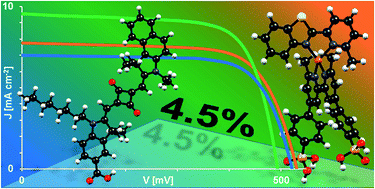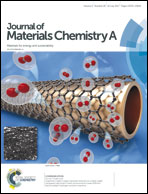The way to panchromatic copper(i)-based dye-sensitized solar cells: co-sensitization with the organic dye SQ2†
Abstract
We report the first example of n-type dye-sensitized solar cells (DSCs) co-sensitized with a copper(I)-based sensitizer and an organic dye. The heteroleptic copper(I) dye [Cu(3)(1)]+ (3 = anchoring ligand ((6,6′-dimethyl-[2,2′-bipyridine]-4,4′-diyl)bis(4,1-phenylene))bis(phosphonic acid), 1 = ancillary ligand 2-(6-methylpyridin-2-yl)thiazole) was combined with the commercially available squaraine derivative SQ2. By prudent matching of the external quantum efficiency (EQE) maxima arising from the two dyes in complementary parts of the visible spectrum, we have achieved the highest photoconversion efficiency reported for a copper-based DSC (65.6% relative to N719 set at 100%). This confirms the potential for the use of Earth-sustainable copper as the basis of sensitizers in DSCs. A combination of J–V measurements (J = current density, V = voltage), EQE spectra and electrochemical impedance spectroscopy has been used to optimize and understand the effective use of the co-sensitized DSCs. We have shown that the sequences in which the photoanodes of the n-type DSCs are exposed to [Cu(3)(1)]+ and SQ2, and the times that the electrodes are immersed in the respective dye baths, critically influence the overall performance of the DSCs. A degree of aggregation of the SQ2 molecules on the electrode surface is important in terms of achieving panchromatic light-harvesting of the co-sensitized DSCs, but excessive aggregation is detrimental.

- This article is part of the themed collection: Celebrating Excellence in Research: Women of Materials Science


 Please wait while we load your content...
Please wait while we load your content...